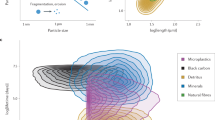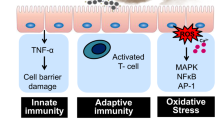Abstract
KNOWLEDGE of the composition of airborne particles and the reactions that take place in the atmosphere is important to the understanding of the fate of these particles. Lead compounds are present in a concentration of about 1% in the particulate and information about their composition would be especially helpful to people conducting experimental studies on the health effects of lead in air.
This is a preview of subscription content, access via your institution
Access options
Subscribe to this journal
Receive 51 print issues and online access
$199.00 per year
only $3.90 per issue
Buy this article
- Purchase on Springer Link
- Instant access to full article PDF
Prices may be subject to local taxes which are calculated during checkout
Similar content being viewed by others
References
Hirschler, D. A., Gilbert, L. F., Lamb, F. W., and Niebylski, L. M., Ind. Eng. Chem., 49, 1131 (1957).
Engle, R. E., Hammer, D. I., Horton, R. J. M., Lane, N. M., and Plumlee, L. A., Environmental Lead and Public Health (Environmental Protection Agency, Air Pollution Control Office, 1971).
Robinson, E., and Ludwig, E. L., J. Air Poll. Control Assoc., 17, 644 (1967).
Robinson, E., Ludwig, F. L., DeVries, J. E., and Hopkins, T. E., Variations of Atmospheric Lead Concentration and Type with Particle Size (Stanford Research Institute, 1963).
Pierrard, J. M., Environ. Sci. Tech., 3, 48 (1969).
Author information
Authors and Affiliations
Rights and permissions
About this article
Cite this article
HAAR, G., BAYARD, M. Composition of Airborne Lead Particles. Nature 232, 553–554 (1971). https://doi.org/10.1038/232553a0
Received:
Revised:
Issue Date:
DOI: https://doi.org/10.1038/232553a0
This article is cited by
-
Chemical transformations of lead compounds under humid conditions: implications for bioaccessibility
Environmental Geochemistry and Health (2013)
-
Feasibility of oak leaves as monitor for airborne pollution
Journal of Radioanalytical and Nuclear Chemistry Articles (1993)
-
Analysis of organobromine compounds and HBr in motor car exhaust gases with a GC/microwave plasma system
Fresenius' Zeitschrift für analytische Chemie (1987)
Comments
By submitting a comment you agree to abide by our Terms and Community Guidelines. If you find something abusive or that does not comply with our terms or guidelines please flag it as inappropriate.



